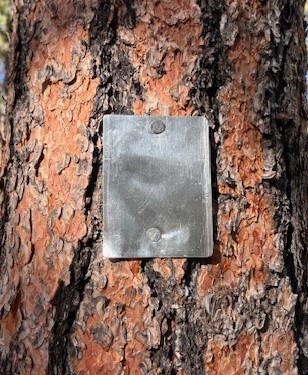By Janet Sellers
Trail markers, aka trail blazes
We will soon see some newer trail markers on trees in Fox Run Regional Park. Volunteers with the Friends of Fox Run Park made great efforts recently to put up new, silver-colored markers safely tacked to pine tree bark, (older versions were blue), but the markers have been disappearing for unknown reasons. These are traditional trail markers, especially useful and necessary in snowy, icy weather when we cannot see the actual trail.
Our high desert forest clime is dependent on its skin of soil and plants to survive. When we honor this part of the forest we cannot see, the part we can see has a better chance to thrive amid us humans, the invasive species. The trail markers thereby help protect the delicate forest ecosystem because we can stay on the trail and not damage the ecosystem underneath our big, human, heavily shod feet or the bicycles people ride. Please respect the forest floor, the “soul of the forest” and only step on trail areas. The trees will thank you by living longer and we can enjoy each other for a long, long time.

Berry propagation
When the berry canes go dormant, it’s the perfect time to snip up some of the canes and root them. That’s one way to get a lot of berry plants. The primary canes are the new growth. They don’t make berries in their first year. There are many ways to root berry canes from the primary canes. Some gardeners say to snip the canes to 8 inches and store them until spring, others say to snip the canes and immediately set them to root in a rooting medium and care for them until spring planting.
Blindfold the Xmas cactus for blooms
Now is the time to cover the holiday cacti to force blooms in six weeks. They need 12 hours of darkness a day at about 55 degrees, so a cool spot is vital. With this 12-hour darkness trick, you can get Christmas cactus to bloom several times a year. Bring them out to enjoy when buds form. If the buds fall off, that could be due to a draft, too much sunlight, water or warmth. They thrive with these tips that seem like neglect.
November is also a good time to protect your garden plants and soils with some pine mulch. Six to 8 inches deep help keep them protected over the winter, letting in moisture, protecting the ecologically vital microbiome and even the insects birds need.

Janet Sellers is an avid lazy gardener, letting Mother Nature show the way to enjoy gardening, harvests, and flowers. Please send your handy hints to JanetSellers@ocn.me.
Other Gardening articles
- High Altitude Nature and Gardens – Wild Horse Fire Brigade: successful fire mitigation since the beginning of…plants (7/31/2025)
- High Altitude Nature and Gardening (HANG) – Gardening with nature’s beautiful bouncers (7/3/2025)
- High Altitude Nature and Gardening (HANG) – Enjoying nature in summer, high altitude landscaping, and weed control (6/7/2025)
- High Altitude Nature and Gardening (HANG) – May: new trees from tree branches, plant partners, bee kind (5/3/2025)
- High Altitude Nature and Gardening (HANG) – Earth Day and the joys of gardening (4/5/2025)
- High Altitude Nature and Gardening (HANG) – Wild outdoors: pine needle bread, gardening in March (3/1/2025)
- High Altitude Nature and Gardening (HANG) – Fermented February, cocoa mulch, and a chocolate “workout” (2/1/2025)
- High Altitude Nature and Gardening (HANG) – January is a seed starter month (1/4/2025)
- High Altitude Nature and Gardening (HANG) – Winter, our backyards, and forests (12/5/2024)
- High Altitude Nature and Gardening (HANG) – The garden as investment: gardening is like banking (10/5/2024)
